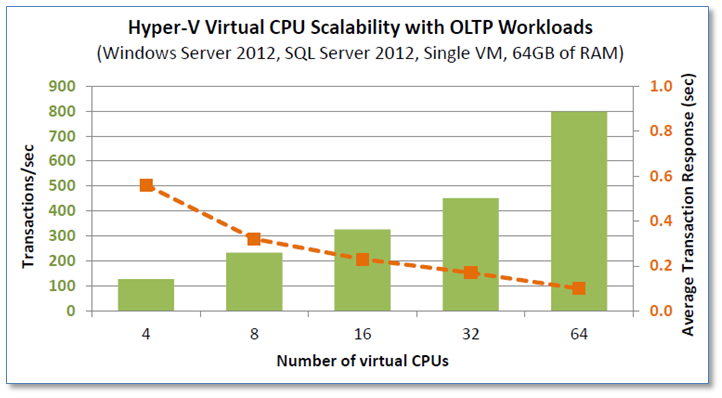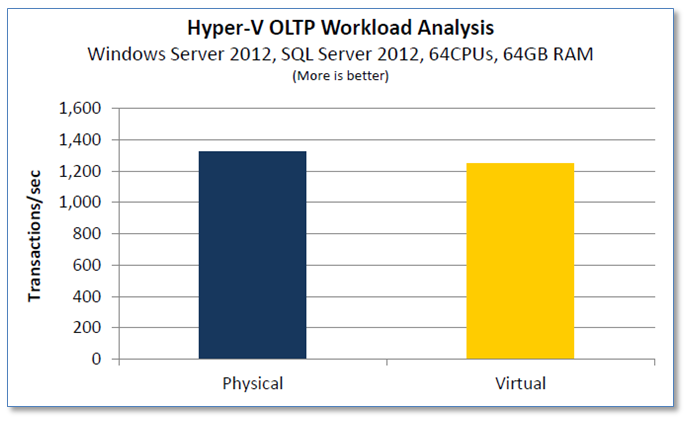Windows Server 2012 Hyper-V Delivers On Scalability and Performance for Virtualized Enterprise Applications
In a previously published blog on enterprise application performance, we’ve talked about Windows Server 2008 Hyper-V’s ability to support your various tier-1 and 2 server application workloads in virtualized environments. The great news is that with the newly released Windows Server 2012 Hyper-V, virtualized enterprise application scalability and performance has gotten even better, now taking advantage of features like support for up to 64 vCPUs, up to 1 TB of memory for Hyper-V guests, and a new VHDX format supporting disk capacity up to 64 TB.
When Windows Server 2012 became available to our customers earlier this year, we asked ESG Labs to conduct an independent evaluation of Windows Server 2012 Hyper-V running SQL Server 2012 tier-1 workloads in a virtualized environment and report on their findings. We were thrilled to see the results, which demonstrated significant improvements in performance, scalability and the ability to reduce TCO. This was coupled with extremely low virtualization overheard.
You can review the 16 page full and 2 page summary reports for yourself at our Virtualizing Enterprise Applications site, where you can also find the results of all our previous enterprise workload testing as well.
The key findings from ESG Labs were:
- With Windows Server 2012 Hyper-V’s new support for up to 64 vCPUs, ESG Lab took an existing SQL Server 2012 OLTP workload that was previously vCPU limited and increased the performance by six times, while the average transaction response times improved by five times.
- Manageably-low Hyper-V overhead of 6.3% was recorded when comparing SQL Server 2012 OLTP workload performance of a physical server to a virtual machine configured with the same number of virtual CPU cores and the same amount of RAM.
The following graph from the report demonstrates a virtual machine running a SQL Server 2012 database supporting 75,000 brokerage customers. During this, ESG Lab tested a constant workload that simulated 40 concurrent users, which resulted in a decrease in transaction response times as Hyper-V virtual CPUs were added.
Additionally, an OLTP workload that deliberately hit a CPU bottleneck in the virtual environment was tested. The same workload against the same database was tested on the physical server. As shown in the graphic below, an OLTP workload running on a 75,000 customer database deployed in a Hyper-V virtual machine processed just over 6% fewer transactions per second compared to the same workload running on a similarly configured physical server (1,245 transactions per second in the virtualized environment, compared to 1,325 in the physical deployment). Which would be an undetectable difference to any end user.
The outcome of this testing demonstrated that Windows Server 2012 Hyper-V delivers a virtualization foundation which can address the demanding needs of IT organizations, while providing all the cost savings and operational efficiencies that virtualization has to offer, along with an extremely negligible impact on performance.
Again, you can review the 16 page full and 2 page summary reports for yourself at our Virtualizing Enterprise Applications site, where you can also find the results of all our previous enterprise workload testing as well. Just click the “+” next to each of the workloads to read the details and you’ll find the reports under the “Related Resources” section in each area.
Seeing is believing and if you’d like to twist the dials yourself on Windows Server 2012 Hyper-V or find more information, visit our Windows Server 2012 site where you can download the 180 day evaluation version and try it out.
Thanks for your time and I hope you find the information to be helpful.
---- Larry

